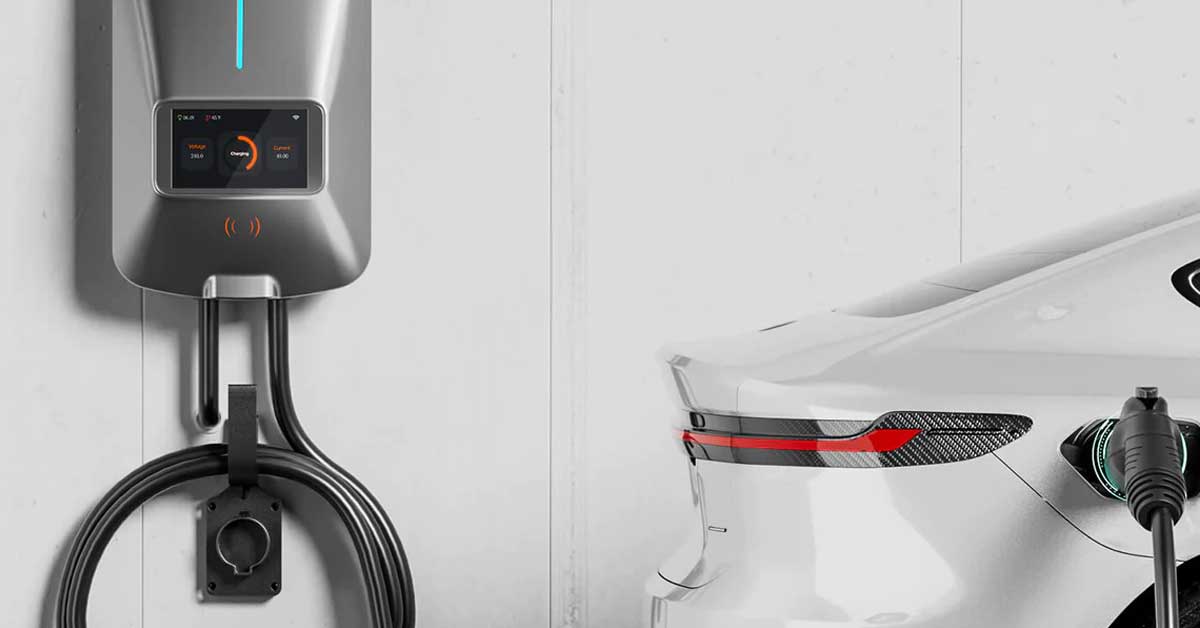REVIEW – I’ve owned a Tesla for about 3 months now, and it’s been an incredible daily driver. But I’ve always relied on my local charging station to re-charge. It’s a bit of an inconvenience, and I knew I needed a solution for charging while parked at my own home.
WOLFBOX, a manufacturer we’ve collaborated with in the past, recently sent me their Level 2 EV Charger to try for myself. I feel pretty fortunate to have received it to unbox and test out on my own.
It’s a new release that boasts an impressive 240-volt connection at up to 40-amps, offering nine times to charge speed as a Level 1 charger. It combines several smart features including a mobile app and RFID card to offer simple plug and charge capabilities in your own garage.
I’ve been using it for about 2 weeks now, and I’m here to report on my findings. Let’s get right into it.
Unboxing and First Impressions
Upon its arrival, the WOLFBOX Level 2 EV Charger came in a somewhat large box. I opened it up and found a huge amount of foam padding; a good sign that it shipped safely to my door from Amazon.
Inside the sturdy box I found the following items:
- The main EV power supply unit.
- Wall mount bracket.
- Charging connector holder.
- 5 self-tapping screws.
- 3 machine screws.
- 7 plastic expansion bolts.
- Amperage labels.
- 2 RFID cards.
- User manual.
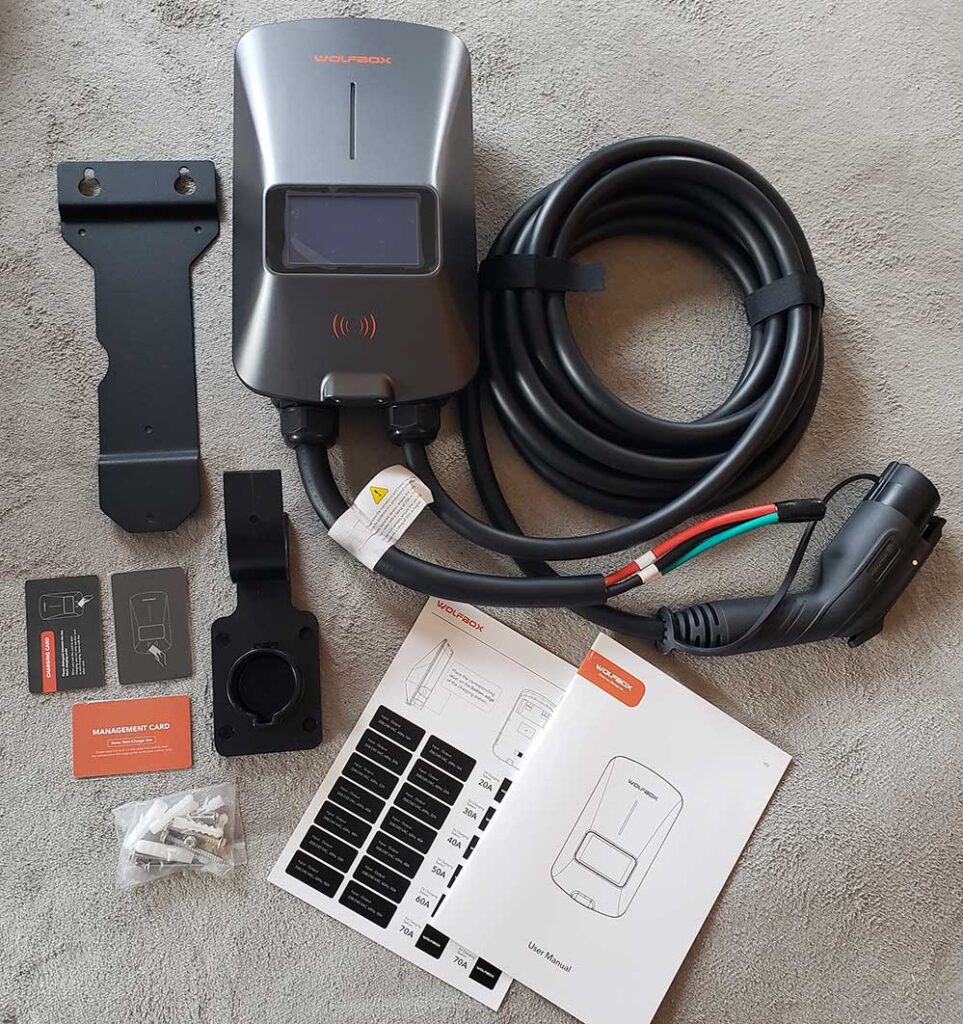
The main unit is sleek, relatively small, yet seemingly well-made in every way. It’s much smaller than I expected it to be, measuring roughly 12″ tall, 8″ wide, and 6″ deep.
I do like the look and color of it, but the all-plastic exterior leaves a little to be desired. I wish it was all metal, or a bit more “solid” feeling.
Anyways, I removed it from the packaging and noticed two large-gauge cables protruding from the base.
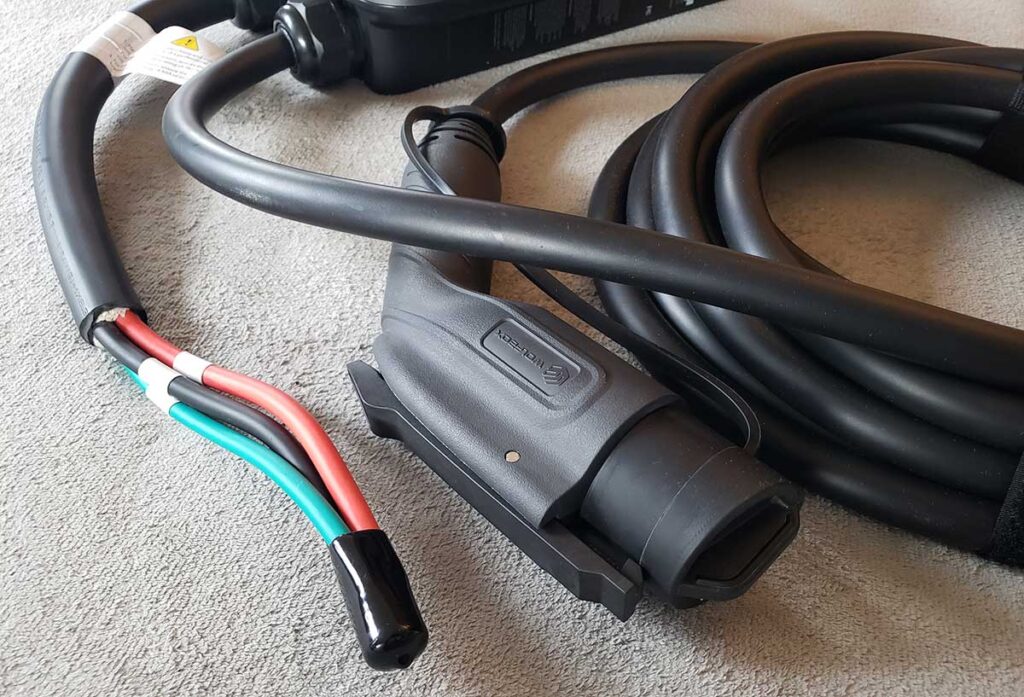
One is a 25-foot charging cable, terminated with a pre-installed J1772 plug. What stood out to me was its huge length. Needless to say, this allows for plenty of reach, no matter how you park.
The other large-gauge cable is a 12-inch hardwire cable that must be connected to a NEMA 14-50 or 6-50 plug (not provided). Now, I’m no electrician, so for install, I needed to call an expert.
Installation
Setting up the WOLFBOX was easy, thanks to the electrician I had install it. Within less than 30 minutes he hardwired it to my home, mounted it, and tested it on my Tesla.
Although I opted to install it in a covered carport, you can choose any indoor or outdoor environment as it’s both water resistant, dustproof, and can withstand a wide range of temperatures.
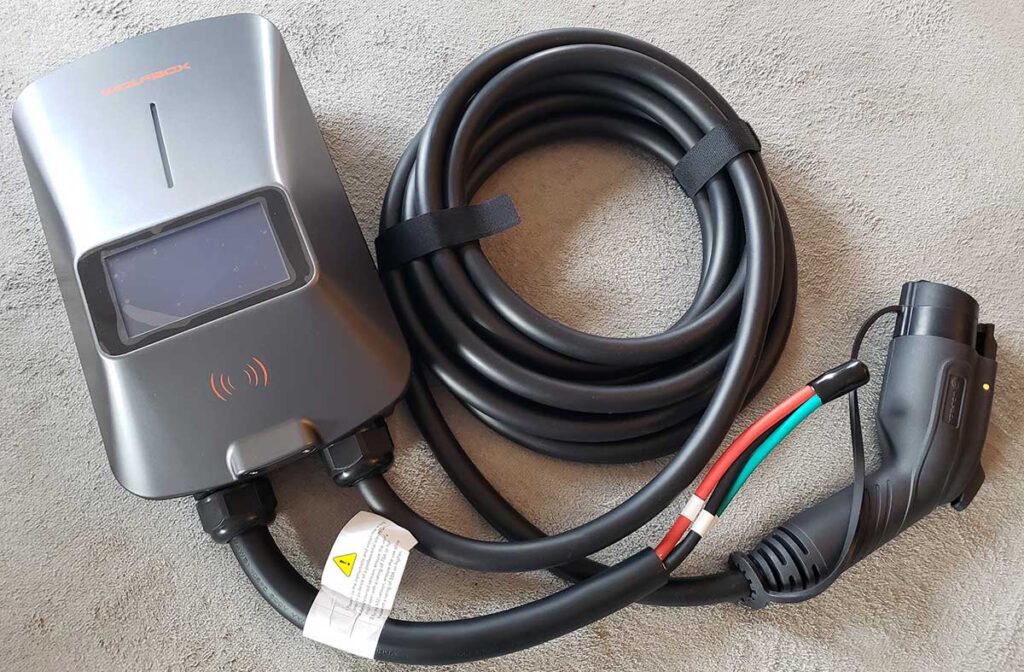
I watched over the electricians’ back throughout the entire installation process, and it looked to be pretty straightforward. Other than hardwiring the J1772 plug, I think I could have installed it myself.
Simply find a stud or something solid to mount it to, use the supplied bracket, and coil-up the cable and set it on the holder. Once installed, the screen lit-up and it was ready to go.
All that said, you can purchase it pre-wired and ready to plug-in, but opting for a hardwired version offers a bit more versatility. In hindsight, I think I would have opted for this pre-wired version, but it’s not that big of deal.
Using the WOLFBOX EV Charger
Now that it was physically installed, I downloaded the Wolfbox EV app on my smartphone, registered, and logged-in. There’s an email verification process that must be completed, but it proved to be effortless.
I connected the app to my WiFi and added the charger to the app interface. In less than 5 minutes, the app was fully configured and ready to go.
The home screen on the app shows a visual of your vehicle with an editable name, current charging output (set to Auto), and options to unlock “plug and charge” mode or set a schedule. I left it unlocked so there was no need to unlock it each time I used it.
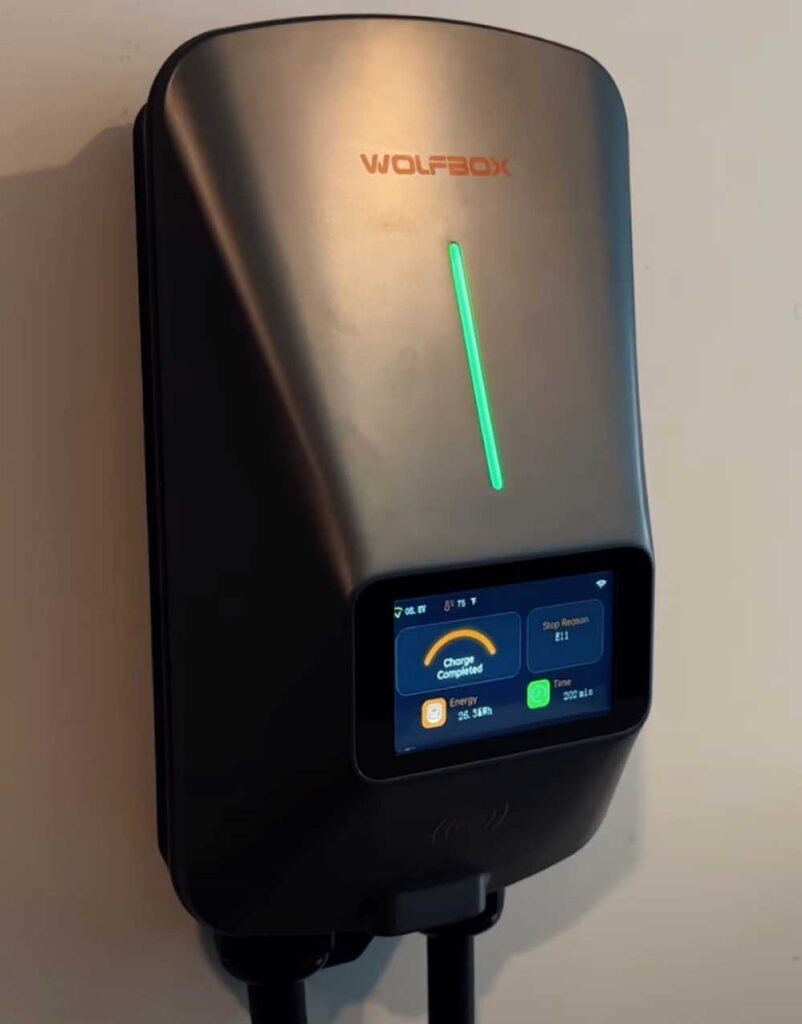
This feature lets users lock the charger so it can’t be used by a third party. You can opt to use one of the included RFID cards or the app to unlock it if you decide to keep it locked with exclusive access.
The app goes quite in-depth with a plethora of options and configuration settings that I won’t bore you with. However, the visuals clearly convey live voltage, current, and temperature with data logging, sharing, and other handy details.
You can even opt to use Alexa or Google Assistant to verbally control the charger. While I admit, I probably will never use these voice features on a day to day basis, I tried them once, and it seemed to function well.
When my Tesla was plugged-in, I really appreciated the LED bar on the front. Based on the color it emits, it clearly indicates a variety of modes:
- Solid Orange: Standby mode – not connected to the network.
- Solid Blue: Standby mode – connected to the network.
- Pulsing Blue: Currently charging.
- Solid Green: Charging is completed.
- Solid Red: Failure has occurred – attention needed.
The level 2 charging capability, operating at 240-volts, is much faster than I originally anticipated. In roughly one hour of being plugged-in, it equates to ~30 miles of range.
After my commute home each evening, my vehicle is always fully charged and ready to go by the time I wake up the next day. The plug feels solid, and the app connectivity always keeps me in the loop on the precise status.
Simply put, it’s a game-changer, especially for someone like me who hasn’t had the luxury of charging at home in the past.
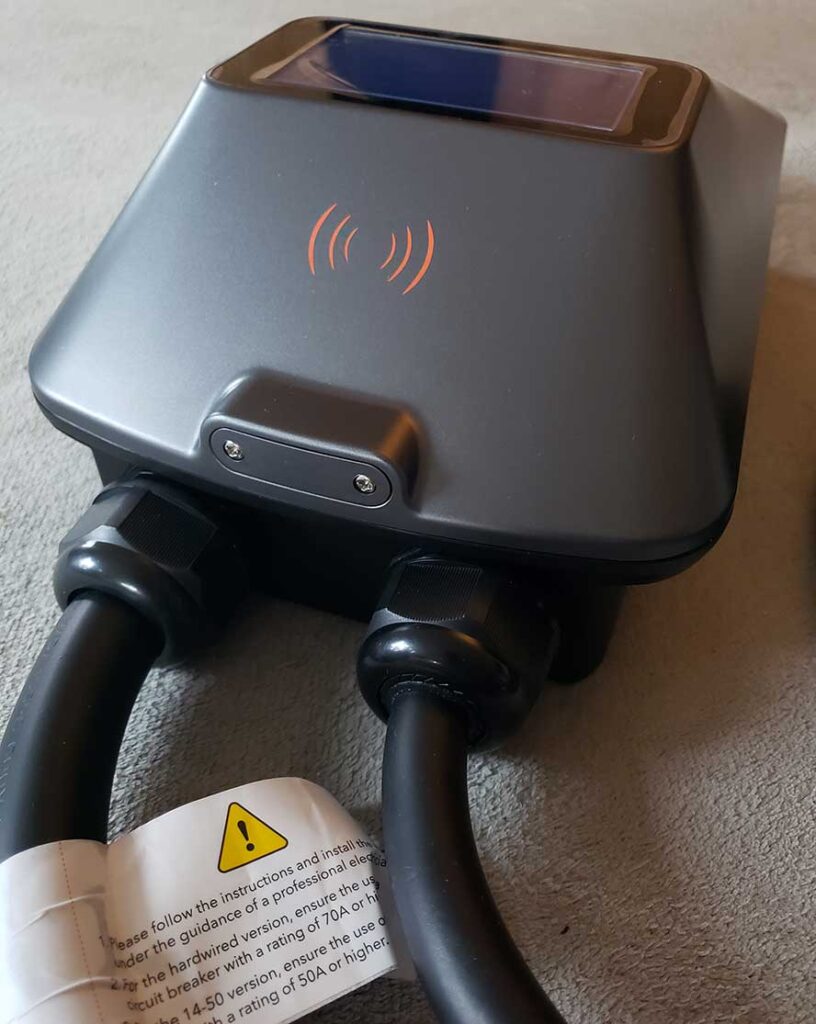
What I Liked
- Works exactly as expected – There was little to no guesswork involved. Installation was straightforward and problem-free. Although I had a licensed electrician assist me, in hindsight, I felt like I could have executed the install myself.
- Minimalist form factor – I love the way it looks. The space gray color scheme and sleek appearance matches my Tesla’s aesthetics to the T.
- Simple operation – Once installed and configured, I felt like this charger offered a very reliable way to re-charge my car. After using it for a couple of weeks, there was never one instance where a fault occurred or any sort of errors.
- App works perfectly – The smart app is well done. It offers a huge assortment of fine-tuning and extra features such as user accounts, scheduling, security, and data logging. Plus, the WiFi connection seems strong, reliable and relatively long-range.
- Scheduling feature – If you know what time of day energy rates are cheapest, you can configure charging to only occur during a pre-set timeframe. This has potential to cut energy costs in the long run.
- Bright display screen – The LCD on the front offers a quick insight into current charging status, amperage and voltage that’s easy to obtain from a quick glance. It contrasts nicely with the black background for a beautifully simple interface.
- Long charging cable – The charging cable that you plug into your vehicle is 25 feet long, which is very generous. I can park in forward or reverse, and the charger has plenty of reach to plug-in, regardless of my cars’ orientation.
- RFID cards – Although I don’t feel like I’ll ever use them, the inclusion of two RFID cards is a nice bonus. This prevents any random Joe Schmoe from walking up to my EV charger and freely using it. That said, the app offers the same kind of security function, if desired.

What I Didn’t Like
- Professional installation required – Since you’re dealing with high-amperage electrical, you should definitely call a licensed electrician for hard-wired installation. Luckily, you can opt for the pre-wired version instead.
- Plastic construction – I’m not a fan of the all plastic exterior construction of the main unit. From a distance it does indeed look nice, however, it feels questionably lightweight given its extreme power capabilities.
Final Thoughts
All in all, I really love the WOLFBOX Level 2 Charger. While I must say, as a new EV owner, I don’t have too much experience with EV charging, and this is my first at-home unit. However, I really love all that it offers.
The smart app with wireless connectivity gives me an interface that is both intuitive and fun to interact with. In every instance while using it, I never had any hiccups to deal with.
The charger works seamlessly and includes a plethora of features that I’m sure anyone would enjoy. While I didn’t regularly use the RFID cards, voice assistance, or scheduling features, I feel that everything else it offers is truly top-notch.
Yes, I wish I received the pre-wired version, the hardwired version offers a bit more flexibility based on installation location. Once the setup was completed, it provided a reliable charging solution that I have very few complaints with.
Have you tried this EV charger for yourself? How do you like it? Let me know by dropping a comment below. Enjoy!
Meet Ry, “TechGuru,” a 36-year-old technology enthusiast with a deep passion for tech innovations. With extensive experience, he specializes in gaming hardware and software, and has expertise in gadgets, custom PCs, and audio.
Besides writing about tech and reviewing new products, he enjoys traveling, hiking, and photography. Committed to keeping up with the latest industry trends, he aims to guide readers in making informed tech decisions.

